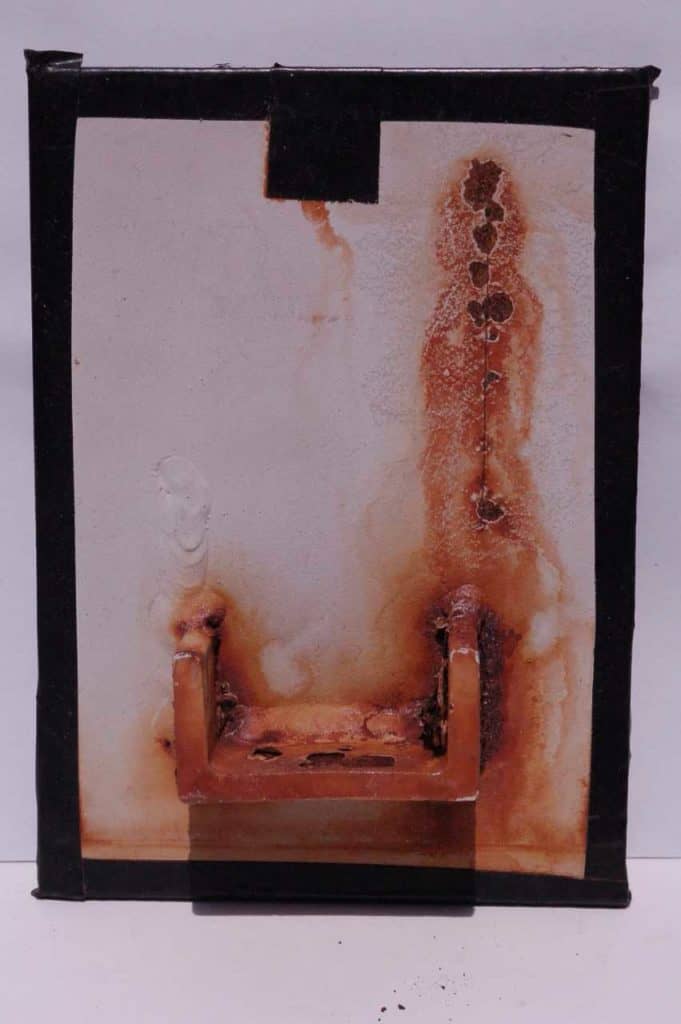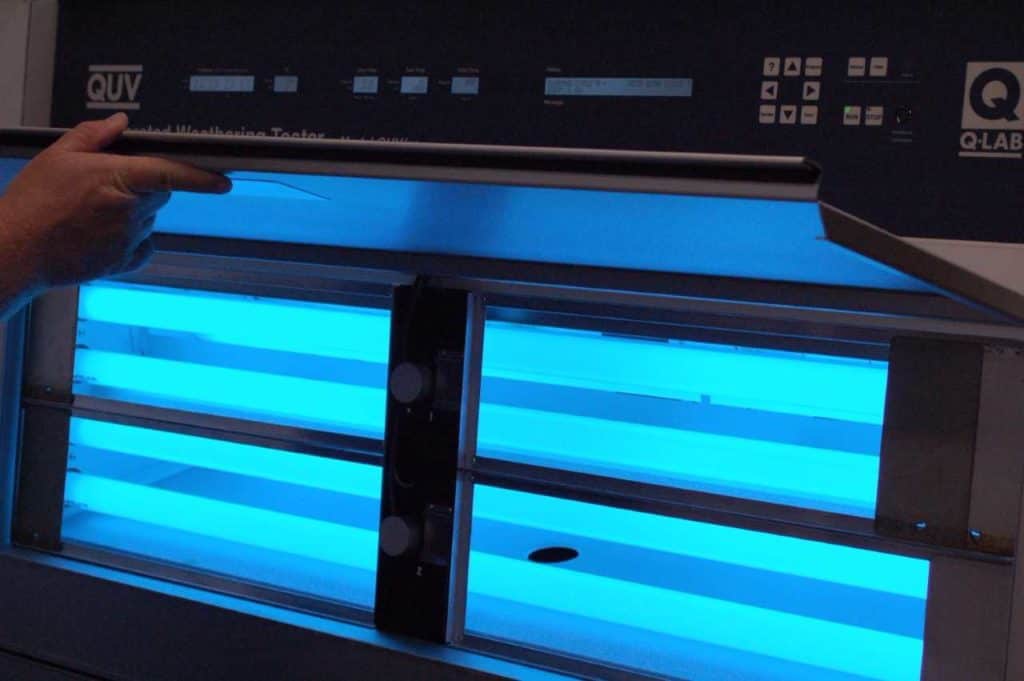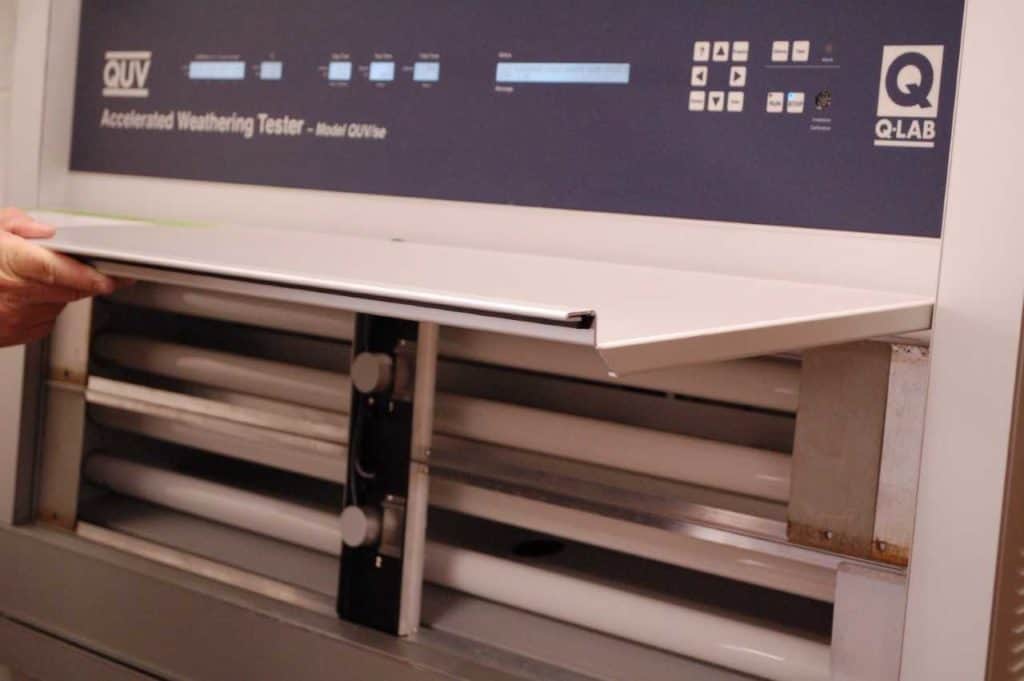“I would like to issue a 30-year warranty on my product. How long of a test should I run to correlate hours to years?” or, “Our engineering standard requires 2000 hours of exposure. Is that long enough?” and what is the correlation in years?” These are important questions, and are challenging to answer. This article attempts to answer these and other questions pertaining to accelerated weathering testing.
We first need to rewind and start with why we run accelerated weathering regimes. Any exposure test, from salt fog to ultraviolet light exposure, simulates a limited number of characteristics of a service environment. We run a test to evaluate a material’s susceptibility to the usual suspects: corrosive conditions, solar radiation, sensitivity to moisture, temperature, pollution, windborne particulates, or a myriad of other, less quantifiable powers (yes, even bird droppings). Exposure tests provide us with a means to expose a material under very specific, measurable parameters, and perhaps accelerate the exposure compared to real-time.

Next, we need to touch on how to run an exposure test to answer our questions. Some exposure regimes incorporate multiple stressors into one cycle, which should be done with caution. If a material underperforms, there may be no means to pinpoint which stressor was the culprit. The mechanism of degradation is different for each of these. Attempting to combine degrative mechanisms into one cycle may not prove beneficial, but rather would complicate the analysis when a failure occurs. Another aspect to consider is the proportion of the duration and intensity of one stressor relative to another. For example, porous materials may experience a greater acceleration factor, as they are more susceptible to moisture intrusion than less porous materials. And because different types of materials react in diverse ways, no one cycle can be specified for every material. Laboratory exposure is simply giving you a means to rank the susceptibility of materials to aspects of the simulated service condition(s). By evaluating the material’s susceptibility to different aspects in separate exposure regimes, you can rank the materials for resistance to moisture separately from their resistance to corrosion, and so on.
There are, however, instances where the mechanisms work in tandem; for example, straight UV light exposure from the sun is rarely specified for exposure of exterior coatings as sunlight and rain (or condensation) work together in nature to degrade materials like plastics and coatings. Artificially generated UV light will destroy polymer bonds and discolor pigments the same as the sun; rain and dew then remove the degradation products, exposing fresh polymer and pigment. One exposure test, ASTM D5894, Standard Practice for Cyclic Salt Fog/UV Exposure of Painted Metal, (Alternating Exposures in a Fog/Dry Cabinet and a UV/Condensation Cabinet) combines ultraviolet light, heat, moisture, corrosive conditions, and temperature cycling into one regime. The corrosive portion of the Standard Practice incorporates nature’s byproducts of pollution and naturally occurring salts, ammonium sulfate and sodium chloride, in a slightly-acidic (pH 5.0-5.4), low concentration solution. ASTM D5894 is often the go-to single exposure regime to simulate several aspects of a standard outdoor environment.
Let’s say the “why” behind your test is that your products are on display at retail stores along the coast, outdoors in the summer months (e.g., the coating on a canopy covering the main entrance). After one season, corrosion is apparent along all the edges. You decide to specify a salt spray regime to qualify all future materials used for that product. Your “how” is going to include products in the test with known susceptibly, starting with your one-season wonder as control sample #1. Ideally, including a low-end performer and a high-end performer of similar composition to the material under test is preferred to judge whether the exposure was severe enough, or too severe. Note that the exposure of the control specimens must be performed concurrently.
Performance of the control specimen can then be compared to the same material from the actual service environment to judge if the mode of failure matches up. This is especially true for UV light exposure. If the problem in the field is chalking and the accelerated testing that is performed produces yellowing and blistering, the exposure may have been too hot or too moist, with not enough (or the incorrect wavelength of) UV radiation. Spectral distribution and peak irradiance are important factors to consider. The output of most UV-producing devices simulates only a very narrow band of wavelengths – typically the wavelengths that are most deleterious to the material under test. Irradiance in the UVA range of wavelength is known for its degradation of polymers. Wavelengths in the UVB range, contrarily, can give erroneous results because the unnaturally short wavelength is found in small quantity naturally, and is non-existent in the winter months in some regions. If the intent is to design an exact regime to replicate (as close as feasible) actual service conditions, it is important to gather data or measure the meteorological parameters. Once you have determined the correct spectral distribution, you could intensify the natural sunlight (thus accelerating your exposure) by concentrating it into one area using mirrors.
 Despite the “whys” and precautionary mumbo-jumbo, some of you may be skimming this article looking for the numerical correlation between accelerated testing and real-time exposure (particularly for the most common of the UV/heat/condensation devices, which is the QUV chamber). Since I don’t want to disappoint the skimmers, references from various sources (most with no professional reputation) have stated that 1000 hours (6 weeks) in a QUV chamber is equivalent to anywhere from 6 months to 2 years of natural exposure. Of course, this is particularly dependent on the duration of your light and dark cycles, temperature, lamp type, the latitude of your location, and so on. Mother nature is not calibrated, nor does she boast a particularly robust coefficient of variation. Rest assured, however, that your test will provide a reliable comparison of results under specific test conditions, and those conditions could (potentially) be repeated by another entity or in the future, all without knowing just how many months your test was intended to represent. This raises another point: can you compare results obtained in one apparatus to results from another (same model) apparatus, or to results obtained at a different time? Both are generally not recommended, so it follows that establishing a pass/fail criterion should not be practiced. UV light exposure tests generally have good reproducibility, if the test results are evaluated in terms of performance ranking only. Attempting to evaluate a product for resistance to UV light in a test chamber against an external criterion will likely place more than just your coatings into hot water.
Despite the “whys” and precautionary mumbo-jumbo, some of you may be skimming this article looking for the numerical correlation between accelerated testing and real-time exposure (particularly for the most common of the UV/heat/condensation devices, which is the QUV chamber). Since I don’t want to disappoint the skimmers, references from various sources (most with no professional reputation) have stated that 1000 hours (6 weeks) in a QUV chamber is equivalent to anywhere from 6 months to 2 years of natural exposure. Of course, this is particularly dependent on the duration of your light and dark cycles, temperature, lamp type, the latitude of your location, and so on. Mother nature is not calibrated, nor does she boast a particularly robust coefficient of variation. Rest assured, however, that your test will provide a reliable comparison of results under specific test conditions, and those conditions could (potentially) be repeated by another entity or in the future, all without knowing just how many months your test was intended to represent. This raises another point: can you compare results obtained in one apparatus to results from another (same model) apparatus, or to results obtained at a different time? Both are generally not recommended, so it follows that establishing a pass/fail criterion should not be practiced. UV light exposure tests generally have good reproducibility, if the test results are evaluated in terms of performance ranking only. Attempting to evaluate a product for resistance to UV light in a test chamber against an external criterion will likely place more than just your coatings into hot water.
 The last question to answer is: how do you evaluate the results of accelerated weathering? Visual effects such as chalking, blistering or rusting are obvious and straightforward, as there are corresponding ASTM standards that can be used to guide these evaluations. Less visible property changes such as sensitivity to moisture can be evaluated by a hardness test or solvent resistance. One of the more comprehensive methods is the evaluation of barrier properties using electrical impedance spectroscopy (EIS) or other electrochemical means. EIS involves applying an AC potential to an electrochemical cell, and then measuring the response. The result is the change in resistance, as observed by change in magnitude and phase shift. Note however that detecting changes in barrier properties of coatings that are 15-20 mils or more using EIS can be quite time consuming and require long term exposures.
The last question to answer is: how do you evaluate the results of accelerated weathering? Visual effects such as chalking, blistering or rusting are obvious and straightforward, as there are corresponding ASTM standards that can be used to guide these evaluations. Less visible property changes such as sensitivity to moisture can be evaluated by a hardness test or solvent resistance. One of the more comprehensive methods is the evaluation of barrier properties using electrical impedance spectroscopy (EIS) or other electrochemical means. EIS involves applying an AC potential to an electrochemical cell, and then measuring the response. The result is the change in resistance, as observed by change in magnitude and phase shift. Note however that detecting changes in barrier properties of coatings that are 15-20 mils or more using EIS can be quite time consuming and require long term exposures.
Conclusion: everything is relative. Just like every being on the planet, we are somehow related, and yet unarguably unique. Every service environment has a completely unique “DNA” of circumstances that will drive you crazy trying to replicate. Side-step the confusion by relying on low-end and high-end performers of known durability in all your exposure tests, and the required duration will reveal itself. Instead of searching for the perfect exposure regime and the ideal duration, save the frustration for another project, and break down the opposition into components that you can precisely measure and control.



Excellent explanation, Carly. Would you be interested in publishing this in Powder Coated Tough magazine? I’m their technical editor.
Thank you,
Kevin Biller
Kevin,
Thanks for your interest in publishing our article! We will contact you after the Holidays to discuss.
Excelent article.
I have waited for it for many years.
I would like that somebody with good knowledge in coatings and good English Spanish translation skills could make a spanish versión.